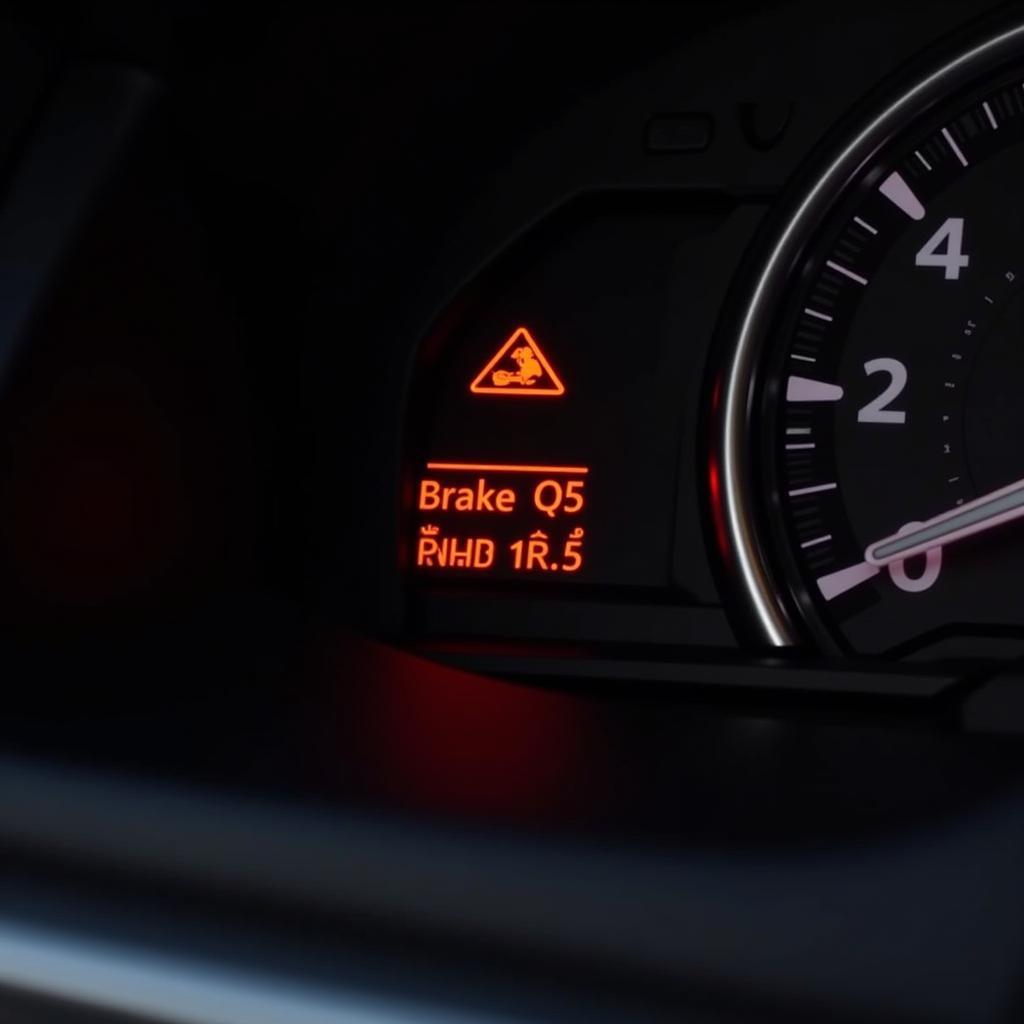The brake pad warning light on your Audi Q5 dashboard is a vital safety feature, illuminating when your brake pads wear down and require replacement. Ignoring this warning can compromise your braking performance and lead to costly repairs. This article explores the common causes, troubleshooting tips, and solutions for a brake pad warning light on an Audi Q5.
Understanding the Audi Q5 Brake Pad Warning System
 Audi Q5 dashboard with illuminated brake pad warning light
Audi Q5 dashboard with illuminated brake pad warning light
The Audi Q5 utilizes an electronic sensor system to monitor brake pad wear. Embedded within the brake pad assembly is a small sensor that triggers the warning light on your dashboard when the pad material reaches a critically low level. This system provides a clear and timely alert, allowing you to address the issue before it escalates.
Why is My Audi Q5 Brake Pad Warning Light On?
While worn brake pads are the most common culprit behind the illuminated warning light, several other factors could be at play:
- Worn Brake Pads: Over time, the friction material on your brake pads wears down, eventually triggering the sensor and illuminating the warning light.
- Faulty Brake Pad Sensor: Like any electronic component, the brake pad sensor itself can malfunction. A short circuit, corrosion, or damage to the sensor wiring can trigger a false warning.
- Low Brake Fluid Level: Brake fluid plays a crucial role in transmitting hydraulic pressure to your brakes. If the brake fluid level is low, it can sometimes trigger the brake pad warning light.
- Issues with the ABS System: While less common, problems with your Audi Q5’s Anti-lock Braking System (ABS) can also trigger the brake pad warning light.
What To Do When Your Brake Pad Warning Light Comes On
If your brake pad warning light illuminates, it’s crucial to take immediate action:
- Assess Your Braking Performance: Pay close attention to how your brakes feel. Do you notice any unusual noises, vibrations, or a decrease in braking effectiveness?
- Check Your Brake Fluid Level: Safely park your Audi Q5 and locate the brake fluid reservoir under the hood. If the fluid level is low, add the appropriate DOT 4 brake fluid.
- Schedule an Inspection: Even if your brake fluid level seems fine, it’s essential to schedule an inspection with a qualified mechanic specializing in Audi vehicles. They can diagnose the issue accurately and recommend the necessary repairs.
Diagnosing the Issue: From Simple Checks to Professional Diagnostics
Determining the root cause of the brake pad warning light often involves a multi-step process:
- Visual Inspection: A visual inspection can reveal heavily worn brake pads, damaged sensor wires, or leaks in the braking system.
- Diagnostic Scanning: Modern Audi vehicles, including the Q5, store diagnostic trouble codes (DTCs) that provide valuable insights into the issue. A qualified mechanic can use a diagnostic scanner to retrieve these codes and pinpoint the problem area.
- Component Testing: The mechanic may need to test individual components, such as the brake pad sensors, ABS sensors, or the ABS control module, to identify the faulty part.
Audi Q5 Brake Pad Replacement: What to Expect
Replacing brake pads is a standard maintenance procedure on all vehicles. On an Audi Q5, the process typically involves:
- Lifting the Vehicle: The Audi Q5 needs to be safely lifted using a hydraulic lift to access the brake assemblies.
- Removing the Wheels: The wheels are removed to provide clear access to the brake calipers and pads.
- Compressing the Brake Caliper Pistons: Using specialized tools, the brake caliper pistons are compressed to create space for the new brake pads.
- Installing New Brake Pads and Sensors: The old brake pads are removed, and new pads, along with new sensors, are installed.
- Reassembling the Braking System: The wheels are reinstalled, and the braking system is thoroughly inspected for leaks and proper operation.
Can I Drive with the Brake Pad Warning Light On?
While it might be tempting to continue driving with the brake pad warning light on, it’s strongly advised against. Driving with significantly worn brake pads compromises your stopping distance and increases the risk of accidents. Moreover, continuing to drive with worn pads can damage other brake components, leading to more extensive and costly repairs.
Brake Pad Warning Light Audi Q5: FAQs
Q: How much does it cost to replace brake pads on an Audi Q5?
A: The cost of brake pad replacement can vary depending on factors like location, labor rates, and the type of brake pads used. On average, you can expect to pay between $300 and $500 for both axles.
Q: How often should brake pads be replaced on an Audi Q5?
A: Brake pad lifespan varies depending on driving habits and conditions. As a general rule, it’s recommended to have your brake pads inspected every 10,000 miles and replaced when the pad material wears down to a certain thickness or triggers the warning light.
Q: Can I replace Audi Q5 brake pads myself?
A: While replacing brake pads is technically possible for experienced DIYers, it’s generally recommended to have this procedure performed by a qualified mechanic. Brake systems are safety-critical components, and any errors during installation can have serious consequences.
Addressing the Brake Pad Warning Light: Prioritizing Safety and Performance
The brake pad warning light on your Audi Q5 is a crucial safety feature, alerting you to potential issues with your braking system. If you notice this light illuminated on your dashboard, don’t ignore it. Take immediate action by assessing your braking performance, checking your brake fluid level, and scheduling an inspection with a qualified mechanic specializing in Audi vehicles. Addressing the issue promptly ensures your safety and the optimal performance of your Audi Q5.

